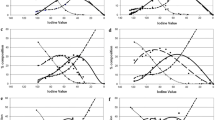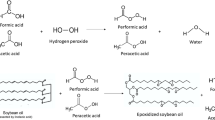Conclusions
1
-
(1)
An increase of temperature, pressure, agitation or amount of catalyst will increase the hydrogenation rate.
-
(2)
In high agitation, at 320 r.p.m. or above, the change of 10° in temperature between 150° to 180° produces little or no effect.
-
(3)
The hydrogenation rate is approximately proportional to the pressure, the amount of catalyst, and one half of the speed of agitation.
-
(4)
No more than one per cent of catalyst is necessary.
-
(5)
The course of the reactions of hydrogenation of soybean oil is the same as with cottonseed oil.
-
(6)
The commercial hydrogenation of soybean oil can be a reality, for it is easily hydrogenated. As in run seven the time for obtaining the fat of 40° melting point was only one and one-half hours, although the time may be different on the commercial scale.
Similar content being viewed by others
References
Rogers “Industrial Chemistry” (1926) 764.
Jour. I. and E. Chem. 9, 459 (1917).
Rogers, ibid. “Industrial Chemistry” (1926) 764.
Moore, ibid. “Industrial Chemistry” (1926) 764.
Lewkowitsch Analysis Oils, Fats and Waxes, I 560 (1921).
Woodman “Food Analysis” (1915) p. 154.
About this article
Cite this article
Gill, A.H., Ma, Y.M. The hydrogenation of soybean oil. Oil Fat Ind 5, 348–351 (1928). https://doi.org/10.1007/BF02562342
Issue Date:
DOI: https://doi.org/10.1007/BF02562342




